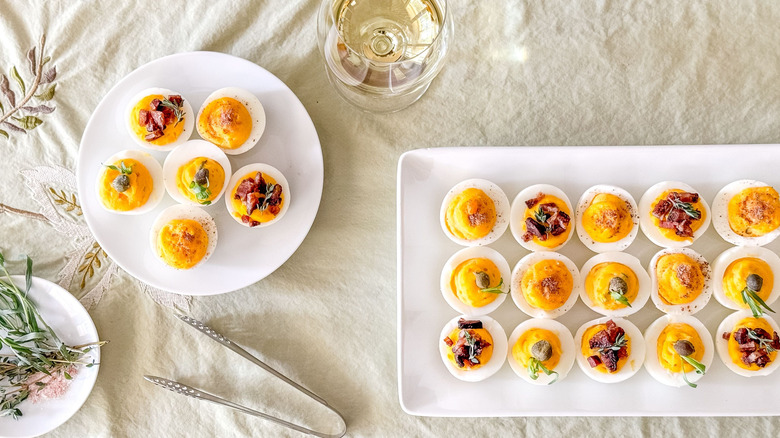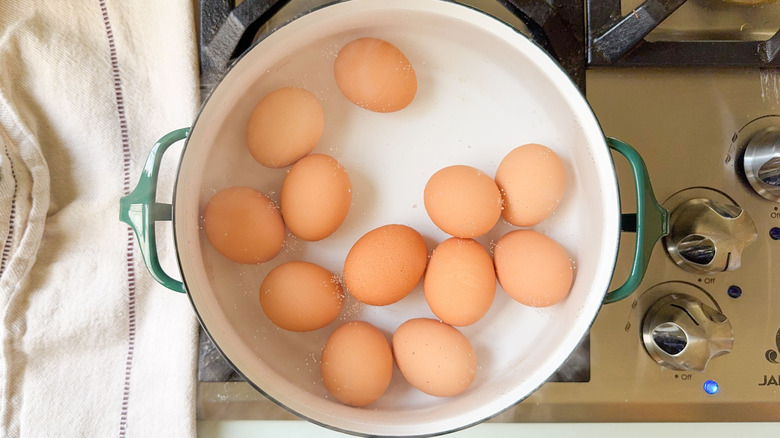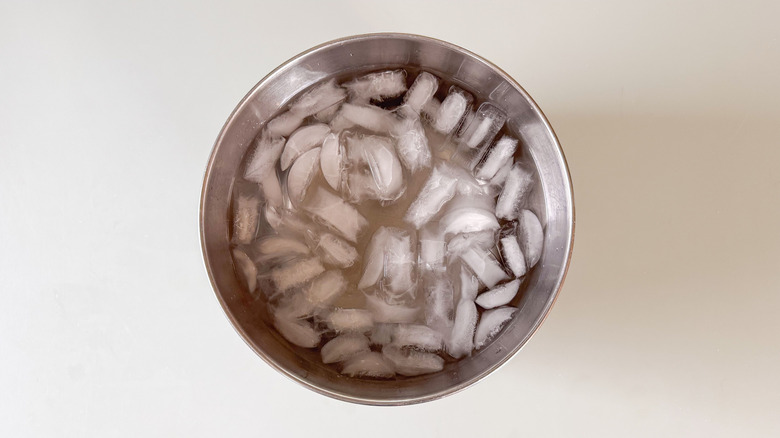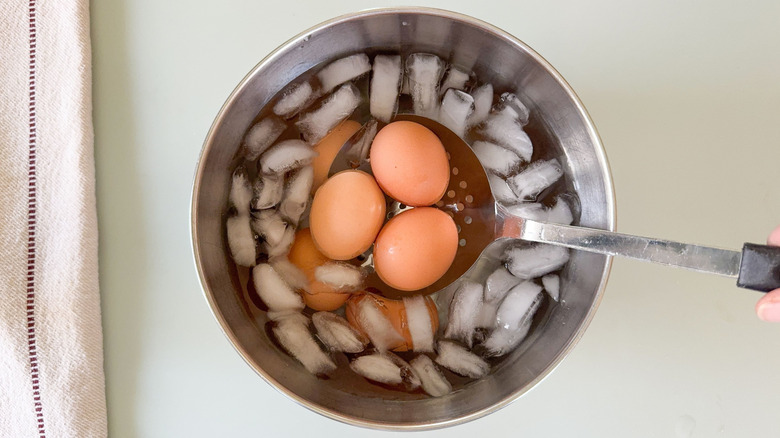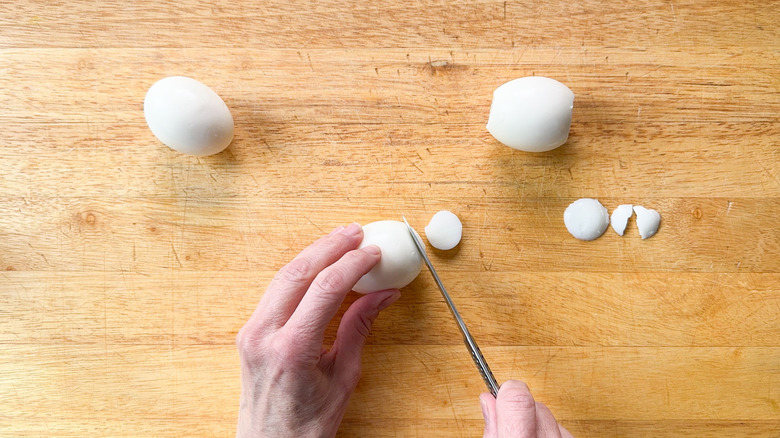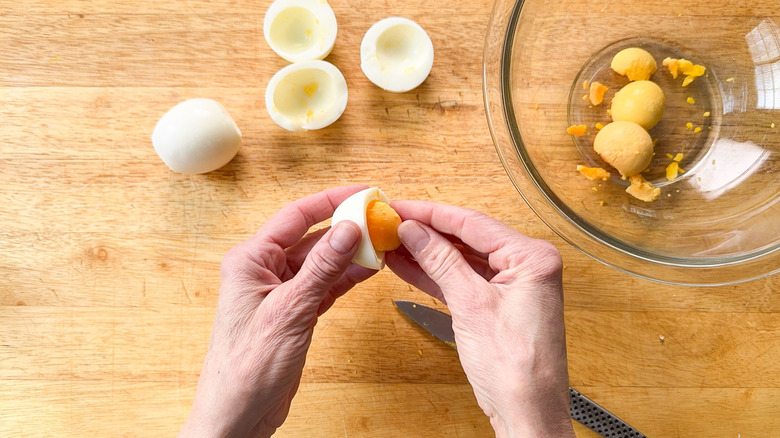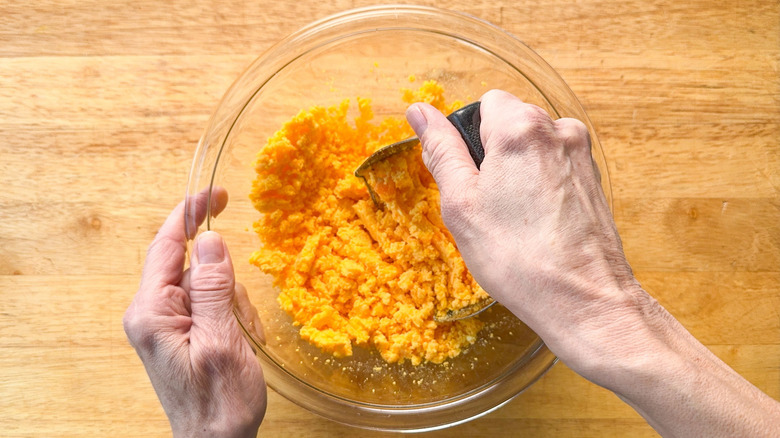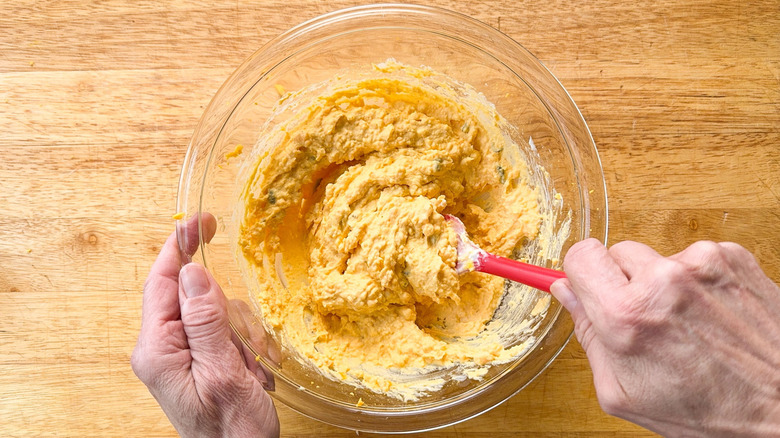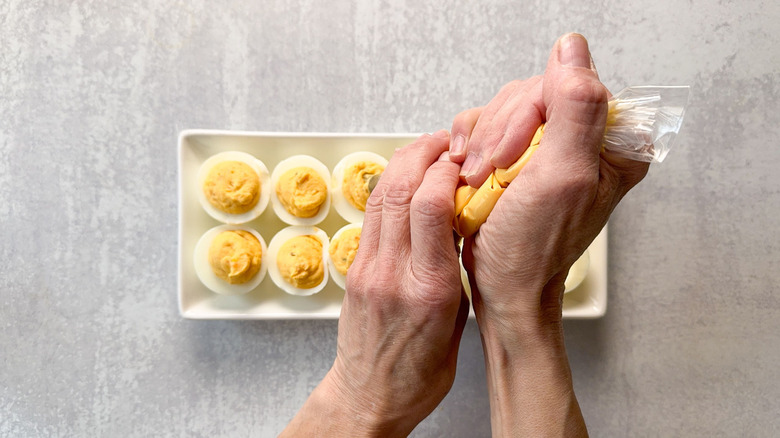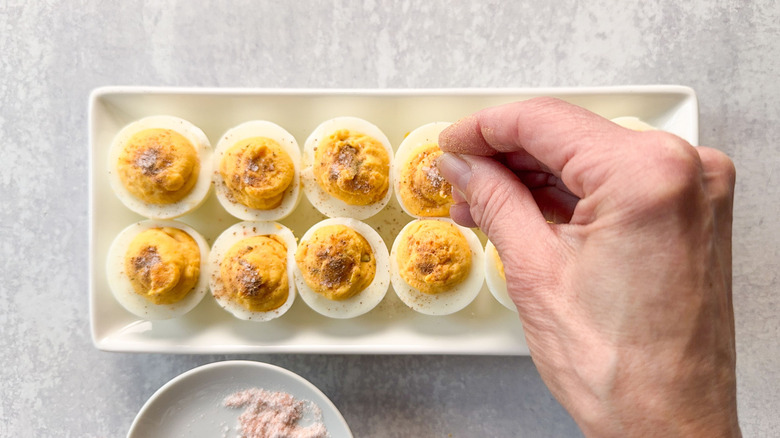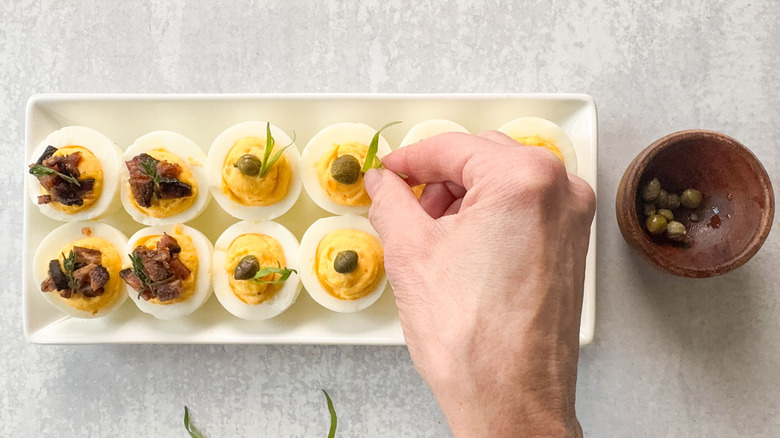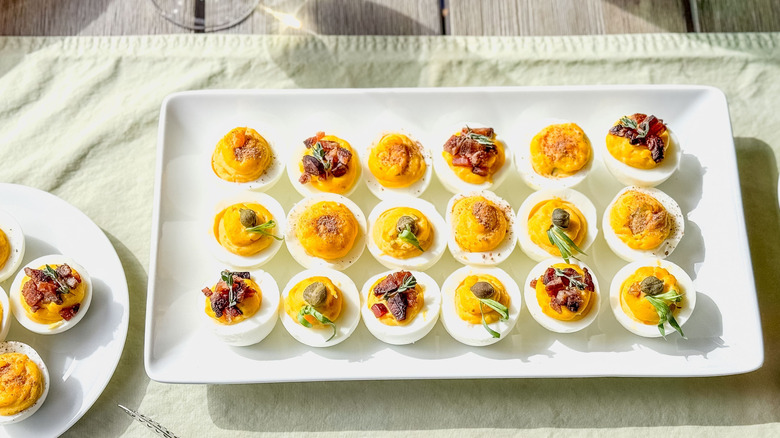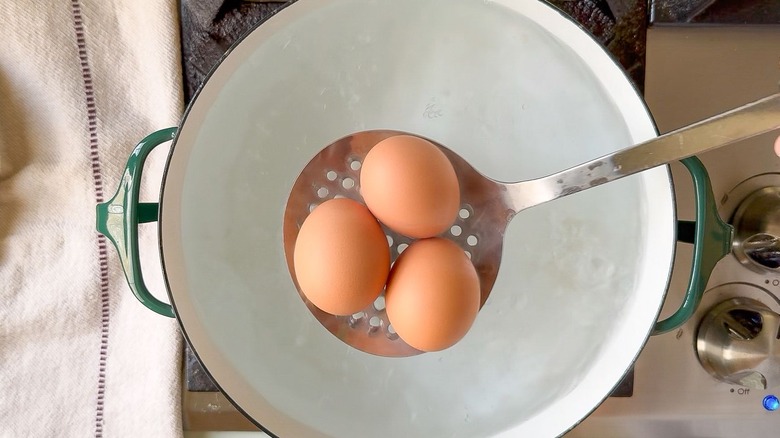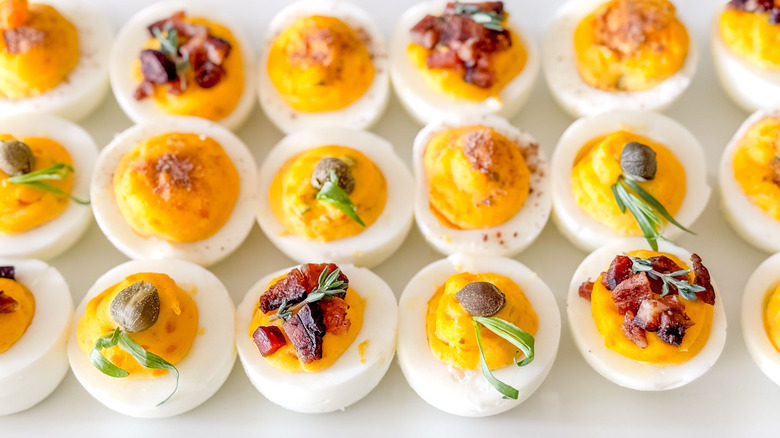Trio Of Easter (Or All-Year) Deviled Eggs Recipe
We may receive a commission on purchases made from links.
Deviled eggs are an Easter brunch tradition and brilliantly tasty way to use up all of those brightly colored and hard-boiled Easter eggs. Although eggs are a time-honored symbol of Easter, historically saved, decorated, and then broken open to eat at the conclusion of Lent, the origins of deviled eggs go all the way back to ancient Rome and medieval Andalusia. Highly-spiced stuffed eggs are one of the world's oldest party foods, described as "deviled" more for their appealing flavor than any sort of sinister connotation. Follow the Romans' lead and break out the deviled eggs anytime with this trio of Easter (or all-year) deviled eggs, courtesy of recipe developer Julie Kinnaird.
Kinnaird takes you through the steps of cooking the eggs, creating a perfect base filling, and assembling a trio of tasty garnishes that are both elegant and crowd-pleasing. Plan ahead by buying your eggs in advance (older eggs prove easier to peel) and get ready to wow your guests with this timeless appetizer.
Gather the Easter deviled eggs ingredients
Start by using eggs that are preferably a week-old from purchase. Kinnaird explains that older eggs have a higher pH level, meaning that the whites will not adhere as strongly to the shell as fresh eggs. After cooking your eggs and removing the yolks, you will mix them with mayonnaise (Kinnaird prefers the Kewpie variety), sour cream, Dijon mustard, and sweet pickle relish. Use a touch of sea salt to heighten the flavors. Once this filling is piped back into the empty egg white shells, use ground nutmeg and sea salt, crisp-cooked bacon and fresh thyme sprigs, and brine-packed capers and tarragon leaves as your garnishes.
Step 1: Boil water for the eggs
Bring a large pot of water to a boil.
Step 2: Cook the eggs
Gently lower the eggs into the water with a slotted spoon. Reduce heat to a low simmer and cook for 12 minutes.
Step 3: Prepare an ice bath
While the eggs are cooking, prepare a large bowl with a water bath of ice and cold water.
Step 4: Place the eggs in the ice bath
Transfer the cooked eggs to the water bath with the slotted spoon.
Step 5: Remove the eggs and refrigerate
Once the eggs are completely cool, transfer them to a container and refrigerate them until ready to use.
Step 6: Peel the eggs
To peel the eggs, gently tap the shells on a hard surface and use your hand to roll back and forth to loosen the shells.
Step 7: Trim the eggs
Trim a small piece of white from both ends of each egg to create a flat surface.
Step 8: Remove the yolks
Cut each egg in half crosswise, remove the yolks, and add those to a large bowl.
Step 9: Place the egg whites on a platter
Place the egg whites flat-side-down on a platter or plates.
Step 10: Mash the yolks
Mash the yolks with a fork until only fine lumps remain.
Step 11: Mix in the remaining filling ingredients
Add the mayonnaise, sour cream, relish, mustard, and ¼ teaspoon sea salt, mixing until smooth.
Step 12: Transfer the filling to a pastry bag
Transfer the yolk filling to a pastry bag fitted with a large round or star tip.
Step 13: Pipe the filling into the egg whites
Pipe some of the filling into each egg white half.
Step 14: Top some of the eggs with nutmeg and sea salt
On about ⅓ of the filled eggs, sprinkle on some of the nutmeg and remaining sea salt.
Step 15: Top the next batch with bacon and thyme
On the next ⅓ of eggs, top the filling with some of the bacon and a sprig of thyme.
Step 16: Garnish the remaining eggs with capers and tarragon
On the remaining eggs, garnish with a caper and a few tarragon leaves.
Step 17: Serve the trio of deviled eggs
Serve the deviled eggs immediately or carefully cover and refrigerate for up to 8 hours.
Trio of Easter (or All-Year) Deviled Eggs Recipe
Deviled eggs are welcome at any gathering, and this recipe, which features a trio of toppings, is perfectly-suited for Easter.
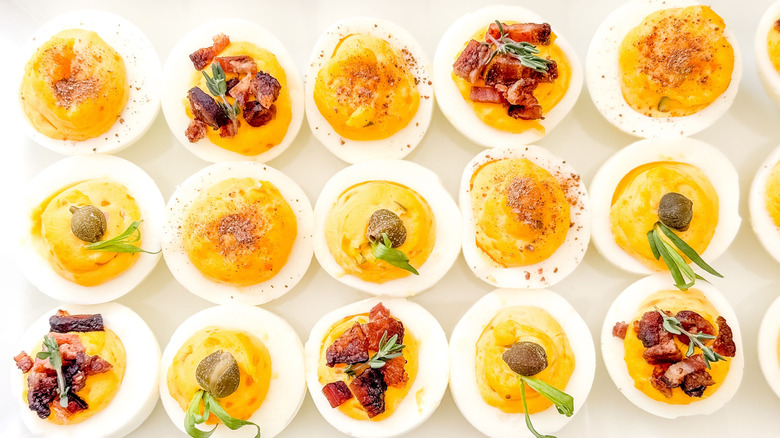
Ingredients
- 12 large eggs
- ⅓ cup mayonnaise
- 3 tablespoons sour cream
- 2 tablespoons sweet pickle relish
- 1 tablespoon Dijon mustard
- ½ teaspoon coarse sea salt, divided
- ¼ teaspoon ground nutmeg
- 2 tablespoons cooked and finely chopped smoked bacon
- 1 tablespoon fresh thyme sprigs
- 1 tablespoon capers in brine, drained
- 1 tablespoon fresh tarragon leaves
Directions
- Bring a large pot of water to a boil.
- Gently lower the eggs into the water with a slotted spoon. Reduce heat to a low simmer and cook for 12 minutes.
- While the eggs are cooking, prepare a large bowl with a water bath of ice and cold water.
- Transfer the cooked eggs to the water bath with the slotted spoon.
- Once the eggs are completely cool, transfer them to a container and refrigerate them until ready to use.
- To peel the eggs, gently tap the shells on a hard surface and use your hand to roll back and forth to loosen the shells.
- Trim a small piece of white from both ends of each egg to create a flat surface.
- Cut each egg in half crosswise, remove the yolks, and add those to a large bowl.
- Place the egg whites flat-side-down on a platter or plates.
- Mash the yolks with a fork until only fine lumps remain.
- Add the mayonnaise, sour cream, relish, mustard, and ¼ teaspoon sea salt, mixing until smooth.
- Transfer the yolk filling to a pastry bag fitted with a large round or star tip.
- Pipe some of the filling into each egg white half.
- On about ⅓ of the filled eggs, sprinkle on some of the nutmeg and remaining sea salt.
- On the next ⅓ of eggs, top the filling with some of the bacon and a sprig of thyme.
- On the remaining eggs, garnish with a caper and a few tarragon leaves.
- Serve the deviled eggs immediately or carefully cover and refrigerate for up to 8 hours.
Nutrition
| Calories per Serving | 66 |
| Total Fat | 5.4 g |
| Saturated Fat | 1.4 g |
| Trans Fat | 0.0 g |
| Cholesterol | 95.5 mg |
| Total Carbohydrates | 0.8 g |
| Dietary Fiber | 0.1 g |
| Total Sugars | 0.5 g |
| Sodium | 84.7 mg |
| Protein | 3.3 g |
What are some tips for success when making deviled eggs?
There is nothing worse than cooking a big batch of hard boiled eggs, only to find yourself struggling with stuck shells and shabby looking whites after peeling. There are plenty of hacks for achieving easy-to-peel and attractive hard-boiled eggs, but here are a few of Kinnaird's favorites. First, start cooking your eggs in boiling water rather than starting them cold. Slower cooking in cold water allows the egg whites to more easily bond with their shells, whereas starting out at a high temperature helps prevent that bond from forming. This leads to easier peeling.
The next step is to immediately place the cooked eggs in an ice water bath to stop the cooking fast. This helps to prevent an unsightly green color on the yolks, caused by a process known as denaturation. Denaturation is caused by overcooking or prolonged heat, which starts a reaction between the iron in the yolks and the sulfur in the whites, forming green ferrous sulfide. Although the yolks are still fine to eat, the off color does not work well for your filling.
To help easily remove the peels from cooled eggs, Kinnaird suggests gently tapping the eggs on a hard surface to break up the shells a bit, then rolling to separate the shell from the white. Once you have removed the yolks, mashing them alone first before mixing in other ingredients will achieve the smoothest texture, allowing you to break up any large chunks. This will also help the mixture move smoothly through a pastry tip when piping into the whites.
What other kinds of toppings could I put on these deviled eggs?
The beauty of this recipe is that it provides a template for exploring a variety of toppings. Kinnaird likes the combination of salty or briny flavors with something fresh and herbal. Rather than capers, try using slices of pimento-stuffed or Kalamata olives with a few slivers of fresh basil or rosemary leaves. Smoked salmon is a great substitute for the bacon, and would pair up perfectly with a sprig of fresh dill. Smoked paprika is a classic garnish for stuffed eggs in place of the warm nutmeg flavor and would be tasty with a sliver of radish and chopped chives. For something really zesty try a thin slice of fresh jalapeño, cilantro, and a dollop of your favorite hot sauce.
To enhance the filling, Kinnaird suggests experimenting with ingredients like miso, avocado puree, or even truffle oil to add different dimensions of flavor and texture. Another spice she likes to include is curry powder, which blends seamlessly with the flavor of the yolks and can compliment garnishes like pickled vegetables, tiny shrimp, or even a crunchy bit of potato chip.
